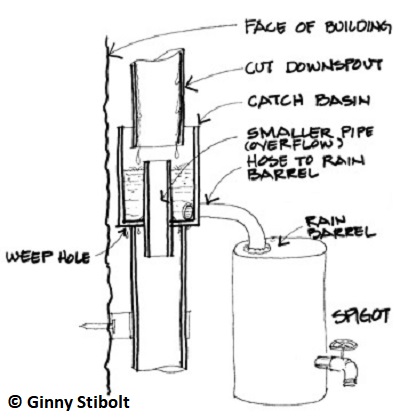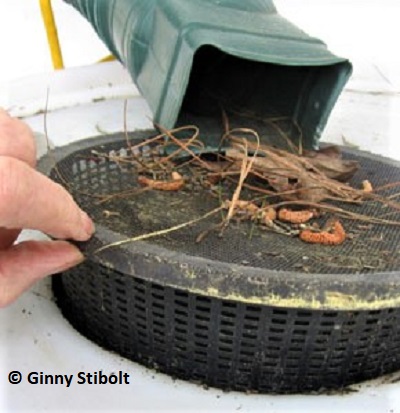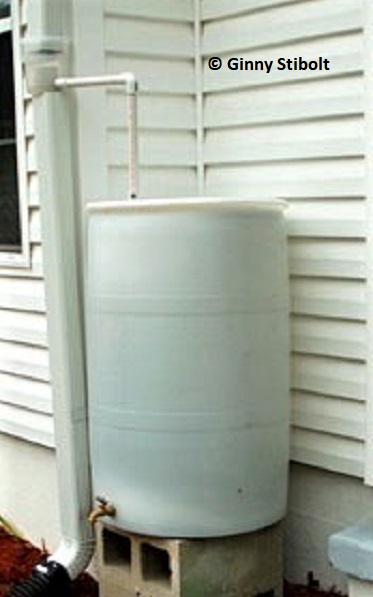Adventures of a Transplanted Gardener |
||
Rain barrels revisited
| ||
 |
<< This illustration by John Markowski is from the rain barrel chapter in my book. The rainwater coming down the spout collects in the catch basin and then flows into the barrel. If it's raining too hard, or if the barrel fills up, the water overflows into the through pipe set into the bottom of the catch basin and continues down the downspout.
My husband fashioned a diverter from a plastic storage
container and standard PVC plumbing parts purchased from Home Depot.
Here are the instructions:
1) Cut a gap in the downspout that is an inch or two shorter than the
height of the catch basin. The catch basin will rest on the bottom
part of the downspout, so you'll need to support the bottom
section of the downspout by fastening it to the building.
2) We used 2.5-inch diameter PVC coupling for the overflow pipe. The
coupling consists of an inner and outer sleeve. The two pieces connect
at the bottom of the catch basin. Cut a hole in the bottom of the catch
basin to be the size of the inner sleeve. It's very important to cut
this hole so there is enough friction to hold it in place. The part
of the coupling extending from the bottom keeps the catch basin in place.
Also create three or four pin-size weep holes so when the rain stops
the extra water can slowly drip out when the barrel is full.
3) We used a series of one-inch PVC pipes and elbows for diverting rainwater
to the barrel--it's shown as hose in the drawing. At the bottom of one
side of the container, create a hole to match hose or pipe to the barrel.
Again you will need a coupling device or lip on the inside of the container
so the hose or pipe doesn't slip out. For a complete layout and photos
of all the parts used see this web
page.
 |
Won't mosquitoes be a problem?
There are three steps we've taken to prevent
mosquitoes:
1) The industrial, food-grade barrels have a lip around the top. We
drilled four holes in the lip of each barrel so the water drains out.
Otherwise an inch or so of water would sit on top of each barrel and
might not evaporate within three days and then mosquitoes would have
time to lay their eggs and hatch.
2) For the closed rain barrel, as described above, we punched out small
weep holes in the catch basin so the water that collects when the barrel
is full can slowly drain away.
3) Our open, three-barrel system collects all the water from one downspout.
This downspout is shortened with a flexible elbow diverter. The
rainwater is directed into a 8-inch wide hole cut into the top of the
first barrel. A plastic basket, with an aluminum screen glued to the
top, sits on its rim in the hole. The screen prevents both mosquitoes
and tree litter from entering the rain barrel.
There are other setups for collecting the rainwater, but we think this is one of the easiest. When all three rain barrels fill up, the extra water first flows into two watering cans and then under the compost piles.
Calculate rainfall to gallons
If you collect rainwater from 500 square feet of roof area (regardless of pitch), a one-inch rainfall will produce 300 gallons of water. Here's the math:
Gallons = 0.6 x (Inches of Rain) x (Surface Area in Square Feet). (The 0.6 is the conversion factor to translate inches of rainfall to gallons. Actually, 0.62333 is possible, but you won't collect every drop of rain. Some of it evaporates, or is blown off the roof, so 0.6 is a good estimate and easier on your brain.) If you receive one inch of rain and gutters collect rainwater from say one fourth of a 2000 square foot roof or 2000 / 4 = 500 square feet, then 0.6 x 1 inch x 500 square feet = 300 gallons of water that will run through the downspout.
How do rain barrels help florida's water supply
While northeast Florida normally has an average annual rainfall of more than 52 inches, and despite the appearance of endless water supplied from north Florida’s beautiful springs, there is a problem in paradise. As the human population increases, with its demand for more and more water, the ground water and aquifers are being strained. We are using too much potable water and wasting a lot of it. If enough Floridians use rain barrel water for some of their needs, it can make a significant difference in water consumption.
Three 55-gallon barrels plus two 3-gallon watering cans is approximately 170 gallons of water and our single closed barrel adds another 55 gallons. In the four years we've been using our barrels, we've only run out of water a couple of times during severe drought. We use the water for our inside plants, porch plants, and to supplement rainfall and irrigation in the landscape. This extra watering is for newly transplanted plants and for vegetables that need a little more water than our conservative irrigation. We turn the irrigation system off during the winter, but the lettuce and carrots appreciate a moist environment, so we hand water them. We also use rain barrel water to rinse our tools and hands, to pre-rinse those carrots, to pour in ant hills, and to keep the compost piles damp.
Add some rain barrels to your home this week to reduce your ecological footprint on Florida.
(Update: Also see the next rain barrel article: Three More Rain Barrels.
Ginny Stibolt is a life-long gardener, a botanist, a naturalist, and a garden writer. You may contact her or read more of her articles posted on her website: www.greengardeningmatters.com.
Copyright Ginny Stibolt


